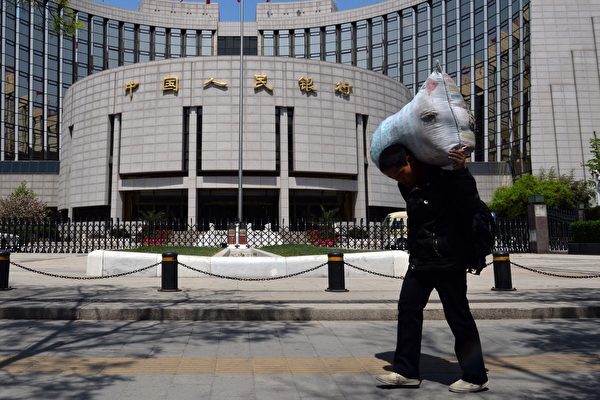Facing the continued economic and stock market downturn, the top leaders of the three major financial regulatory departments of the Chinese Communist Party made a rare joint appearance today (September 24th) to announce a “heavyweight” message. This includes a recent decision to reduce the deposit reserve ratio by 0.5 percentage points and provide approximately 1 trillion yuan (RMB, hereinafter) of long-term liquidity to the financial market. Many believe that the CCP’s move to inject another 1 trillion yuan into the economy may not be sufficient to address the deep-rooted issues.
The State Council Information Office of the CCP held a press conference at 9 a.m. on September 24th, with the Governor of the People’s Bank of China Pan Gongsheng and the Chairman of the China Securities Regulatory Commission Wu Qing in attendance.
Pan Gongsheng stated that they would reduce the deposit reserve ratio by 0.5 percentage points to provide about 1 trillion yuan of long-term liquidity to the financial market. They may consider further reducing the deposit reserve ratio by 0.25 to 0.5 percentage points later this year based on market liquidity conditions.
Pan Gongsheng also mentioned lowering the central bank’s policy rate, specifically lowering the 7-day reverse repurchase operation rate by 0.2 percentage points from the current 1.7% to 1.5%. This move aims to guide loan market quoted interest rates and deposit rates downward simultaneously.
Following the implementation of the above reserve requirement cut policy, the reserve ratio for large banks will decrease from 8.5% to 8%, while for medium-sized banks, it will drop from 6.5% to 6%. Rural financial institutions are not included in the adjustment. With the implementation of the reserve requirement cut policy, the average reserve ratio of the banking industry is expected to be around 6.6%.
The last reserve requirement cut by the CCP was on February 5th of this year, when the deposit reserve ratio of financial institutions was reduced by 0.5 percentage points. After that adjustment, the weighted average deposit reserve ratio of financial institutions was approximately 7.0%.
Many netizens noted the rare joint appearance of the heads of the three major Chinese financial institutions, including the Governor of the People’s Bank, the Director of the China Banking and Insurance Regulatory Commission, and the Chairman of the China Securities Regulatory Commission.
A blogger from Jiangsu, “Butterfly Effect,” remarked that the reserve cut means banks will have more money to lend. He pointed out that this is not the first time the central bank has injected a large amount of liquidity. After the outbreak of the epidemic in 2020, the central bank repeatedly lowered the deposit reserve ratio to stimulate the economy. This latest injection of 1 trillion yuan is even larger than the liquidity injection in 2020.
Another blogger from Guangdong, “Zhou Yuanyuan,” commented on the official’s sense of urgency, noting the unconventional combination of measures announced this time. She highlighted the unprecedented nature of the announcement regarding the reserve cut during the press conference, as such decisions were typically communicated through news briefings. She also emphasized the significant flexibility in the central bank’s statement about creating a favorable environment for the financial market operation, including the stock market.
She pointed out that the timing of the press conference, which was held at 9 a.m. instead of the usual 10 a.m., revealed some unusual signals— opening before the A share market raises questions on the message being sent to the stock market. Wu Qing, the Chairman of the China Securities Regulatory Commission, also made statements during the event.
However, she cautioned that deep-seated issues in the stock market cannot be resolved overnight, and the recent measures are just a signal of intent from the authorities without offering a comprehensive solution. She stressed the need for concrete actions to follow the statements to build trust among investors.
As for mortgage policies, Pan Gongsheng announced a reduction in existing mortgage interest rates and unified minimum down payment ratios for mortgages. The specifics include guiding commercial banks to lower existing mortgage rates to levels near those of new mortgage rates, with an estimated average reduction of around 0.5 percentage points. The minimum down payment ratio for first-time and second-home mortgages nationwide will be reduced from 25% to 15%. Additionally, the central bank’s support ratio for the 300 billion yuan secured housing refinancing scheme created in May will be increased from the original 60% to 100%. The deadline for the operating property loans due by year-end and the “16 Measures” financial policies has been extended to the end of 2026.
A blogger from Hunan, “The Trend of Small Caps is Up,” analyzed the recent decision to reduce the deposit reserve ratio by 0.5 percentage points and the upcoming reduction in existing mortgage rates, indicating the start of a significant liquidity boost.
Regarding the official’s plan to unify down payment ratios for first and second homes nationwide, lowering the minimum down payment ratio for second-home mortgages from the current 25% to 15%, “The Trend of Small Caps is Up” believes that this is the authorities’ last resort to save the urban real estate market. Predictably, food prices in China will rise as a consequence. As a writer once remarked, if food prices soar one day and farmers have no land to cultivate, the price will be the loss of their homes.

